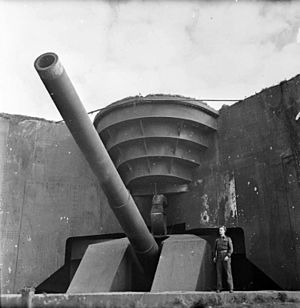
Back Batterie Todt German Batería Todt Spanish Batterie Todt French Batteria Todt Italian Batterij Todt Dutch Batariá Todt Occitan
| Todt Battery | |
|---|---|
| Part of Atlantic Wall | |
| Haringzelle, Audinghen, Pas de Calais, France | |
 A British soldier poses next to the recently captured German 380 mm gun Todt Battery at Cap Gris-Nez. | |
  Kriegsmarine Ensign | |
| Coordinates | 50°50′39″N 1°36′00″E / 50.8443°N 1.5999°E |
| Type | Coastal battery |
| Site information | |
| Owner | Private |
| Open to the public | One casemate is open to the public |
| Condition | Four casemates, in varied condition |
| Site history | |
| Built | 22 July 1940 – 20 January 1942 |
| Built by | Organisation Todt |
| In use | 1942–44 |
| Materials | Concrete and steel |
| Battles/wars | Operation Sea Lion, Channel Dash, Hellfire Corner, Operation Undergo |
| Garrison information | |
| Garrison | |
The Todt Battery, also known as Batterie Todt, was a battery of coastal artillery built by Nazi Germany during World War II, located in the hamlet of Haringzelles, Audinghen, near Cape Gris-Nez, Pas de Calais, France.
The battery consisted of four Krupp 380-millimetre (15 in) guns with a range up to 55.7 kilometres (34.6 mi),[1] capable of reaching the British coast, each protected by a bunker of reinforced concrete. Originally to be called Siegfried Battery, it was renamed in honor of the German engineer Fritz Todt, creator of the Todt Organisation. It was later integrated into the Atlantic Wall.
The 3rd Canadian Infantry Division attacked the Cape Gris-Nez batteries on 29 September 1944, and the positions were secured by the afternoon of the same day. The Todt battery fired for the last time on 29 September 1944 and was taken hours later by the North Nova Scotia Highlanders that landed in Normandy, as part of the 9th Infantry Brigade, 3rd Canadian Infantry Division, after an intense aerial bombardment, as part of Operation Undergo.
- ^ Christopher 2014, p. 95.
© MMXXIII Rich X Search. We shall prevail. All rights reserved. Rich X Search